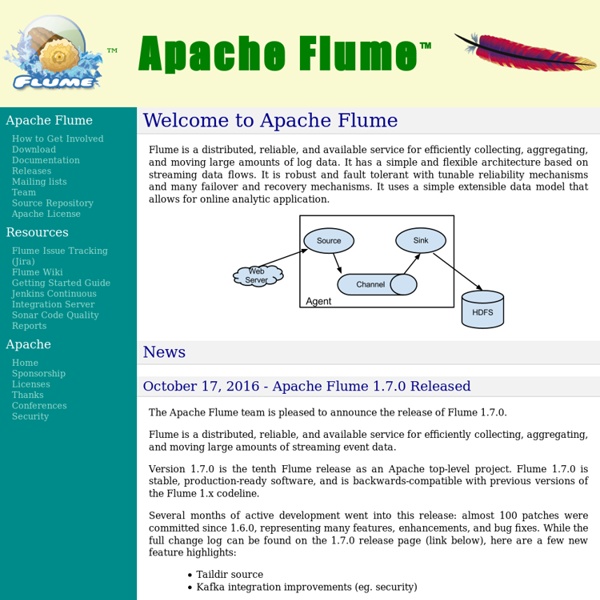



ZooKeeper A.3. Installing and Configuring the Apache HTTP Server The Apache HTTP Server must be installed and configured on all nodes in the assigned failover domain, if used, or in the cluster. The basic server configuration must be the same on all nodes on which it runs for the service to fail over correctly. The following example shows a basic Apache HTTP Server installation that includes no third-party modules or performance tuning. On all node in the cluster (or nodes in the failover domain, if used), install the httpd RPM package. For example: rpm -Uvh httpd-<version>. To configure the Apache HTTP Server as a cluster service, perform the following tasks: Edit the /etc/httpd/conf/httpd.conf configuration file and customize the file according to your configuration. Before the service is added to the cluster configuration, ensure that the Apache HTTP Server directories are not mounted. Add the init script for the Apache HTTP Server service.
Sqoop Install mod_wsgi - wikipbx These instructions are not to be considered authoritative instructions, please see for the official mod_wsgi docs. To install mod_wsgi, you can either: Install from a package (for your Linux distro)Build mod_wsgi from source Install from a packge Ubuntu/Debian apt-get install libapache2-mod-wsgi Build mod_wsgi from source cd /usr/srcwget xvfz mod_wsgi-3.1.tar.gzcd mod_wsgi-3.1/. Instruct Apache2 to load mod_wsgi module Create mod_wsgi.load file cd /etc/apache2/mods-availablevi mod_wsgi.load Add the following text to the file: LoadModule wsgi_module /usr/lib/apache2/modules/mod_wsgi.so Symlink in mods-enabled cd /etc/apache2/mods-enabledln -s .. Restart Apache2 /etc/init.d/apache2 restart Dealing with specific errors You might run into these when attempting to install mod_wsgi. segmentation fault If you get a segmentation fault, it could be caused by a conflict with an existing mod_python module. Reference
HBase apxs - APache eXtenSion tool Available Languages: en | ko | tr apxs is a tool for building and installing extension modules for the Apache HyperText Transfer Protocol (HTTP) server. This is achieved by building a dynamic shared object (DSO) from one or more source or object which then can be loaded into the Apache server under runtime via the LoadModule directive from mod_so. So to use this extension mechanism your platform has to support the DSO feature and your Apache httpd binary has to be built with the mod_so module. The module mod_so should be part of the displayed list. The arguments can be any C source file (.c), a object file (.o) or even a library archive (.a). For more details about DSO support in Apache read the documentation of mod_so or perhaps even read the src/modules/standard/mod_so.c source file. Synopsis apxs -g [ -S = ] -n apxs -q [ -S = ] ... apxs -c [ -S = ] [ -o ] [ -I ] [ -D = ] [ -L ] [ -l ] [ -Wc, ] [ -Wl, ] ... apxs -i [ -S = ] [ -n ] [ -a ] [ -A ] ... Options Common Options -n Query Options -q
Hive! compiling - Mod_Auth_MySQL will not compile under Slackware 13 Apache Pig Linux Tutorial - Apache Web Login Authentication: Apache authentication and autorization Intro: Apache authentication can be configured to require web site visitors to login with a user id and password. This is different than adding a login form on a web page and creating your own authentication. This tutorial describes the various methods available for authentication with Apache and its' configuration. Login protection is applied to the web pages stored in a directory. The login dialog box which requests the user id and password is provided by the web browser at the request of Apache. Apache authentication methods using local files to store passwords, have no association with system user accounts. Terms: Authentication: Prove it is you. Typically Authentication or Authentication and Authorization are required for access. Apache configuration files: (refered to generically in this tutorial as httpd.conf or reside as the file .htpasswd, in the directory being protected.) Apache password file authentication: Apache configuration file: ... #!
bash - Apache htpasswd secure password change GitLab Disclaimer This guide is a rough port from the official guide and various internet references. Some of the steps have been consolidated and obviously customized to the standard Gentoo environment. If something is missing, please make a point of updating this article, with special attention to dependencies please. If you don’t like long installation guides likes this, you can use unofficial www-apps/gitlabhq ebuild from CVUT Overlay. There’s also a short guide for dummies how to install it and configure your web server. Prerequisites/Dependencies root # echo "dev-lang/tk threads" >> /etc/portage/package.use root # emerge --ask openssl icu ruby git redis root # rc-service redis start root # rc-update add redis default Prepare the Necessary Users root # eselect ruby set ruby19 root # eselect python set python2.7 Gitlab uses the git user, so add it: root # useradd -m -s /bin/bash -c 'Git Version Control' -d /home/git git Gitlab Shell root # su git git cd git ~ cd gitlab-shell Important git ~/gitlab-shell .
rails Rails or Ruby on Rails is a web application framework. Install dev-ruby/rails: root # emerge --ask dev-ruby/rails Setup root /var/www # rails new ror root /var/www # cd ror root /var/www/ror # rails server Point your browser @ and your are now riding rails via WEBrick. passenger via apache Emerge passenger. root # emerge --ask passenger add -D PASSENGER to apache's config [Collapse] File/etc/conf.d/apache2add -D PASSENGER to apache's config Passenger needs apache to relax the rules a little bit. File/etc/apache2/modules.d/30_mod_passenger.confapache 2.2 <Directory /> Options FollowSymLinks AllowOverride all Order allow,deny Allow from all </Directory></IfDefine> File/etc/apache2/modules.d/30_mod_passenger.confapache 2.4 <Directory /> Options FollowSymLinks AllowOverride all Require all granted </Directory></IfDefine> backup your original apache vhost: root # mv /etc/apache2/vhosts.d/00_default_vhost.conf /etc/apache2/vhosts.d/00_default_vhost.conf.backup tutorials
A distributed, reliable, and available service for efficiently collecting, aggregating, and moving large amounts of log data. by sergeykucherov Jul 15